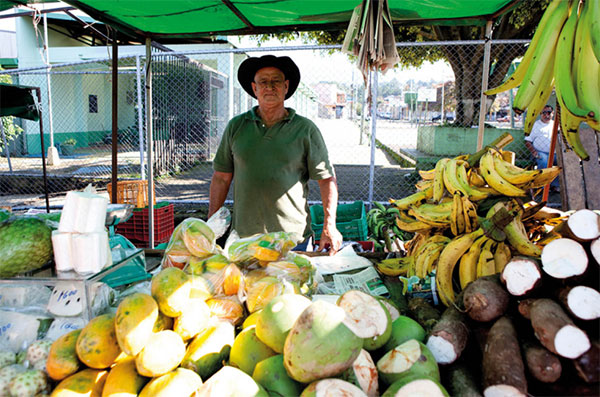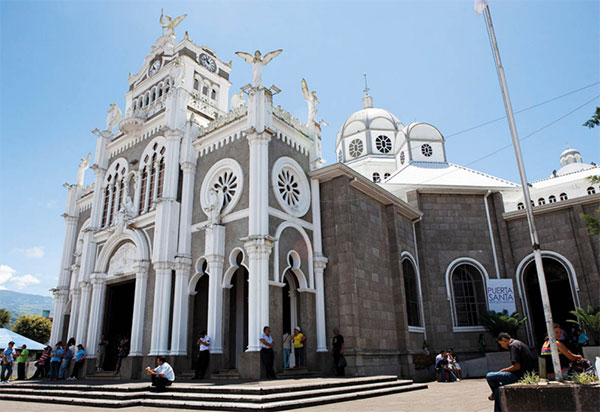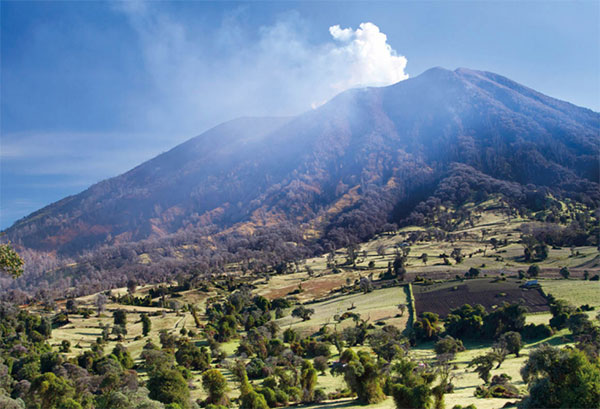PAINTED OX CARTS
Around 1910, as legend has it, a campesino (farmer) was crossing the Beneficio la Luisa when it occurred to him to decorate his oxcart wheels with colorful mandala-like designs inspired by ancient Moorish decoration. The art form quickly caught on and each district in Costa Rica had its own special design. Locals could tell just by looking at the cart where the driver was from. Each cart also had its own chirrido, or song of the wheels, by which people could identify who was passing by, without even glancing upward. As late as 1960, the oxcart was still the most typical mode of transportation, able to handle the rugged Costa Rican terrain to transport goods like coffee beans. Things have changed, but you will still see the occasional oxcart on country roads.
Descend from the park to one of the nearby restaurants and enjoy the local specialty of fresas en leche, strawberries with cream. Alternatively, continue to the nearby La Paz Waterfall Gardens (www.waterfallgardens.com; daily 8am–5pm) and set off on 3.5 km (1.5 miles) of trails past hummingbird and orchid gardens, a huge butterfly observatory, aviaries and animal exhibits, en route to five impressive waterfalls. To spend more time in the mountain air, consider an overnight stay at Peace Lodge or Poás Volcano Lodge (www.poasvolcanolodge.com).

Coconuts for sale at San Raphael de Heredia’s Sunday market.
Corrie Wingate/Apa Publications
Braulio Carrillo National Park
Only 45 minutes from San José is Parque Nacional Braulio Carrillo 6 [map] (daily 8am–3.30pm), a true wilderness. Occupying 445 sq km (170 sq miles) of mostly primary forest, the park was founded in 1978, thanks to pressure exerted by environmentalists who feared that the opening of a highway between San José and Guápiles would provide loggers and developers with access to rapidly vanishing virgin forest.
Braulio Carrillo contains five distinctly separate forest habitats, dominated by the wet tropical forest. Hundreds of varieties of orchids and ferns, and the majority of the bird species native to Costa Rica, are found here. The lingering impression of Braulio Carrillo is of vastness: huge canyons, misty mountains, and the ubiquitous broad-leaf plant, called the Poor Man’s Umbrella, covering the hillsides. The easiest way to experience the forest is to walk the trails at the Quebrada Gonzales station, about 17km (11 miles) past the tunnel. The Las Palmas Trail, starting from the parking lot, gradually climbs up from the highway, quickly immersing you in the forest.

Basílica de Nuestra Señora de los Angeles, Cartago.
Corrie Wingate/Apa Publications
For a bird’s-eye view of the forest canopy adjacent to Braulio Carrillo, you can ride on the Rainforest Aerial Tram (www.rainforestadventure.com; charge includes tram ride, video, and a short hike; reservations recommended). This is an 80-minute, 2.6km (1.5-mile) trip through the forest’s treetops, 35 meters (100ft) above the forest floor. The ‘tram’ is an open, metal gondola, big enough for five passengers and a naturalist guide, who is equipped with a walkie-talkie to pass along information on wildlife sightings.
Cartago and around
Cartago 7 [map] , 22km (14 miles) south of San José, was the capital of Costa Rica until 1823, when it lost its status to San José. Most of its illustrious colonial past is lost, however, since repeated earthquakes and eruptions of Volcán Irazú have destroyed most of the colonial-era buildings.
Cartago, once the center of Costa Rican culture, is still her religious center. The enormous Basílica de Nuestra Señora de los Angeles (Basilica of Our Lady of the Angels), a domed, Byzantine structure that dominates the landscape for many kilometers, was built in honor of Costa Rica’s patron saint, La Negrita, the Black Virgin. It is worth a look inside to see the lovely stained-glass windows and the wood columns painted to look like marble.
From Cartago it is a short trip to the Lankester Jardín Botánico 8 [map] (www.jbl.ucr.ac.cr; daily 8.30am–4.30pm) in Paraíso de Cartago, named, so legend has it, by weary Spaniards moving inland from the Atlantic coast who found its cooler weather and lack of malarial mosquitoes paradisiacal. English botanist Charles Lankester, sent to Costa Rica by a British company to work on coffee planting, arrived in 1900 at the age of 21. The coffee venture failed, but he decided to stay and bought 15 hectares (37 acres) of land to preserve local flora, especially orchids and bromeliads, and to regenerate a natural forest. Today, Lankester Gardens is run by the University of Costa Rica. Hundreds of species of orchids attract orchid fanciers from all over the world, particularly in the peak flowering months of January through April.
Easily accessible from Cartago is Parque Nacional Volcán 9 [map] (daily 8am–3.30pm), atop the massive volcano that dominates the landscape on the eastern side of the Central Valley. From the 3,800-meter (11,000ft) summit, it is possible to see both the Caribbean and the Pacific on a clear day. More often, you will climb above the clouds on your way to the top. Irazú, Costa Rica’s highest volcano, also known as El Coloso, broke a 30-year period of silence with a single, noisy eruption on December 8, 1994.
Nearby Turrialba’s ) [map] reputation as a whitewater river-rafting center is growing, and rafters and kayakers from all over the world are discovering the Reventazón and Pacuare rivers. Looming above the town is Volcán Turrialba, spectacularly active between 2014-16, when the first magma eruption in 100 years took place, followed by strong eruptions of ash and rocks. Today it’s quieter but still a stunning sight.
Caribbean coast
The three-hour drive from San José to the Caribbean coast is on a paved, slow-moving highway winding past the canyons, mountains, waterfalls, and virgin forests of Parque Nacional Braulio Carrillo. Descending from the cool cloudiness into the tropical lowland forests of the Caribbean, the temperature rises, and the air becomes heavy.
Tortuguero
Travel on the Tortuguero canals, up through the area north of Limón, has been likened to a trip on the African Queen, or to floating dreamily down the Amazon. It is certainly one of the most wonderfully lyrical trips to be taken anywhere in the world. As you drift lazily along, awash in the fragrance of white ginger blossoms, lavender water hyacinths, and the ylang ylang flower, the tranquility here soothes all your cares away.

Volcán Turrialba smokes.
iStock